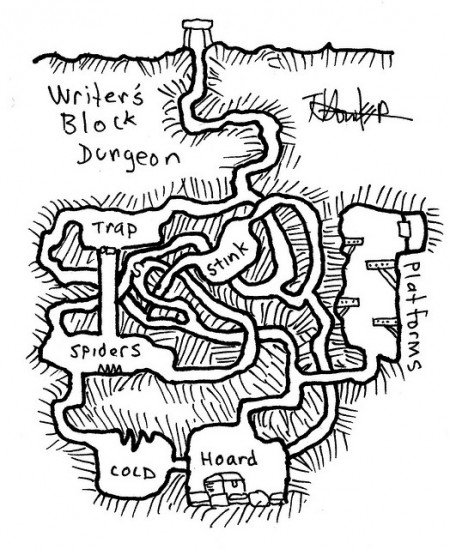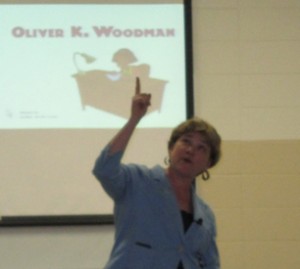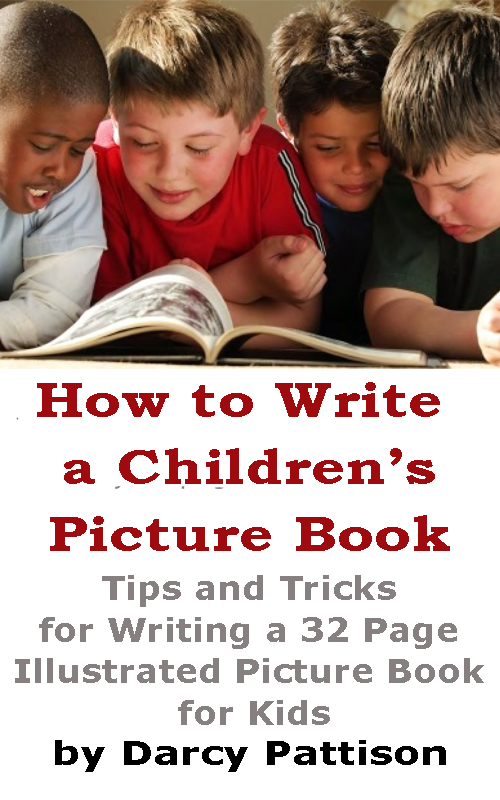new posts in all blogs
Viewing: Blog Posts Tagged with: First Drafts, Most Recent at Top [Help]
Results 26 - 50 of 71
How to use this Page
You are viewing the most recent posts tagged with the words: First Drafts in the JacketFlap blog reader. What is a tag? Think of a tag as a keyword or category label. Tags can both help you find posts on JacketFlap.com as well as provide an easy way for you to "remember" and classify posts for later recall. Try adding a tag yourself by clicking "Add a tag" below a post's header. Scroll down through the list of Recent Posts in the left column and click on a post title that sounds interesting. You can view all posts from a specific blog by clicking the Blog name in the right column, or you can click a 'More Posts from this Blog' link in any individual post.
ONLY 3 DAYS LEFT
I am in the midst of a truly awful first draft. Really. I have NEVER written such a bad first draft.
This is a sequel and it must be written to roughly follow an outline, but the outline seems sorta dead.
Here’s what I am doing:
 Push on. I am pushing forward, trying to write something, anything. Sometimes, the story is flat and sometimes it sings. Doesn’t matter. My goal this week is to finish a draft.
Push on. I am pushing forward, trying to write something, anything. Sometimes, the story is flat and sometimes it sings. Doesn’t matter. My goal this week is to finish a draft.
Trust the process. I am trusting the process. I know that the story won’t end with this draft; there will be multiple drafts after this, plenty of time to fix the glaring problems of this draft. It’s the only reason I am allowing myself to forge ahead, because I know that this is a process, not a static thing that I work on once and never again.
Update: As I pushed forward this week, the story did indeed start to connect as a whole. There are still many elements that are unconnected, but I am confident that I can get there. I keep thinking about Linda Sue Parks comments about her Newbery title, A SINGLE SHARD (Clarion, 2001). She says that she tried to make sure each chapter has something that looks forward and something that looks backward. For example, if she has a character use a gourd to get a drink from a spring in one chapter, she makes it her rule to use that gourd again somewhere else. The story starts with a basket-backpack leaking rice; partly, it starts there because the main character uses a basket-backpack to carry his master’s pottery to the capitol. If the backpack was necessary to the story, according to her rules, she had to use it somewhere else. THAT is what is missing in my story right now. There are elements that I threw into the first draft–because that’s what first drafts are for–but I’m not sure yet, if they will weave into the fabric of the story. For example, the main character notices in chapter one that someone has a nickname and realizes that he doesn’t have one. Right now, the story doesn’t resolve that. I need to either remove the reference entirely–or the story has to deliver him with a really great, appropriate nickname.
Experiment. Everything is going so badly anyway, that I feel free to experiment. I am throwing in snatches of conversation, snippets of a scene, trying out wording for actions–in other words, experiment. I would say that I am playing, but this time, there is just the hint of despair in the writing, since it is going so very badly. I am really searching for a voice that works. Maybe it needs another narrator? Maybe it needs a different setting? Anyway, I am allowing tangents that I would normally cut off.
Role of First Drafts. Most of all, I remember: the purpose of the first draft is to figure out what story you are telling. The purpose of all other drafts is to figure out the most dramatic way to tell that story. I remember that I am figuring out what story I am telling. So–I allow myself to, well, to figure it out. Slowly, painfully–the story is starting to shine through. It will be there within this draft, waiting for me to recognize it and polish it. I am just trusting the process and writing a really lousy first draft.

I am working on a first draft of a story and am reminded of a couple things.
First, you must write the story. You can plan all you want, but the story comes alive in the actual writing. A small thing this week: my main character is afraid of all bugs. That includes insects and anthropods (spiders)–anything that crawls or flies. So, there they are, the Main Character(MC) and Best Friend (BF) sitting in art class and painting. Guess what the BF paints? An anteater! It’s a perfect addition to the story but I hadn’t planned on it. It came about simply because I wrote the first draft of the first chapter. And there it was.
We don’t know what we think until we write.
We don’t know what the story is until we write.
It’s like sports. You can predict who will win or lose a game, but the teams must still play the game. And there are always surprises.
Write your story. It will surprise you.

The second thing that is happening is not as nice. The story is boring.
I am still feeling my way through the story to find the line of tension, the exciting bits. I’ll keep writing even if it’s boring, because I am digging up anteaters. To use another bug metaphor, I’ve spun a web and I am sitting like a spider monitoring the web for the slightest hint of movement. When the movement–or story excitement–happens, I’ll be ready to pounce. It’s called trusting the process. It’s the most exciting and satisfying thing about writing, when a story comes together on many levels. It’s also scary: I KNOW this is a boring chapter, too full of static action and talking heads. I KNOW it’s bad. I could throw up my hands and just quit. Instead, I’ll plod along and write through the problems until I find something exciting. I can delete this boring chapter later (and, I will!). For now, I am trusting the writing process to get me to a stronger story. And it will.




By
Biljana Likic
—
 First drafts never come easy. They rarely turn out exactly how you’ve planned them, if you’ve even planned them at all. The other day, fellow pantser and Pub Crawler JJ posted about endings being one of the most challenging things for her, and offered useful advice on how she deals with the inevitable wall blocking her way to the goal.
First drafts never come easy. They rarely turn out exactly how you’ve planned them, if you’ve even planned them at all. The other day, fellow pantser and Pub Crawler JJ posted about endings being one of the most challenging things for her, and offered useful advice on how she deals with the inevitable wall blocking her way to the goal.
I’m the total opposite. I always know my endings. I know from the start how everything will turn out, which characters, if any, will die, and what kind of world order will be in place. If I don’t, then I have no will to write. I can have the perfect world constructed, but if I don’t have an ending to suit a story, I may as well have never created it.
But this far from makes things easier, nor does it make them necessarily harder. It’s just a different way of writing. Beside my shining, glittering, golden ending is a looming pit of darkness in need of filling. It’s true, the edges are faintly lined with tentative opening chapters, and there are some generic filler ideas peeking through the gloom, but mostly it’s a pit of darkness.
The most effective method I’ve found to defeat the pit of darkness is by making mistakes.
This is something we’ve all heard before: You’ll never learn until you’ve made mistakes. And it’s usually followed by sagely uttered words about knowledge gained in how to avoid them. But here’s an idea. If you’re writing your first draft and you start making mistakes, don’t fix them. If you’re in a place where your ideas aren’t set in stone anyways, you have nothing to lose. Explore the notion that the mistake you made is actually the right answer.
Here’s an example of what I mean. A few months ago, I was writing a wedding scene. I was writing it out of sheer desperation because I had no idea how to progress the story even though my ending looked so beautiful in the distance. The bride had recently lost her parents under suspicious circumstances, and was unhappily getting married to a man who employs her very close family friend. Naturally, this family friend will be present at the wedding. The bride needs all the support she can get, especially since she’s pretty much getting married against her will. The family friend hates the groom despite working for him, but will be there because he knows that the bride will need a friendly face in the crowd. Let’s be honest here; the only reason this character exists is because she needs an ally.
It wasn’t until weeks later that I realized I’d totally forgotten to include him in the wedding ceremony. And the reception. And all the subsequent scenes of the bride feeling abysmally lonely. In other words, a character whose sole function of being a person’s support system collapsed into a heap of moot possibilities.
I couldn’t believe my stupidity. I mean, this guy was best friends with her father. He’s known her since she was born. This was going to be his shining moment. What the frak was he doing that was more important than the wedding?!
I was about to go all the way back to the beginning of the event to start writing in cameos heavily featuring trivial exchanges and encouraging smiles when I started thinking…
…What was he doing that was more important than the wedding?
That one mistake, followed by that one question, ended up giving me enough fodder for ten thousand words of new plot and created a conspiracy theory that will last me the entire story.
I can’t even imagine the story anymore where the family friend is present at the wedding. I can’t stop the eye-roll when I think about how useless he was. And you have to be a pretty damn useless character for a writer to forget about you completely during a scene where you should be excelling at your purpose.
This is what I mean by making mistakes. Rather than fixing them, explore them.
Obviously, some mistakes lead to plot holes, and this way of writing is mostly beneficial to people who don’t plan details. But even so, it’s easy to get stuck on a concept just because you feel you have no choice but to keep it. In some ways, committing to these kinds of mistakes is the equivalent of murdering your darlings before they’ve even been created. Sometimes choices are hard to come by. Other times the imperfect human memory hands them to you so elegantly you think you made the mistake on purpose.
In any case, next time you realize you’ve made a huge error, try to think of its possibilities before chucking it. You may have subconsciously created a better situation for yourself.
After all, most great things are discovered by accident.
—
Biljana Likic is currently revising her first novel. She’s in her fourth year of university, where she can’t wait till she’s out so she’ll finally have all the time in the world to write. You can visit her personal blog and follow her on Twitter.
There’s an excitement in the air! I’ve started a new novel project.
Here’s what I don’t want to happen:
I don’t want the excitement for this project to get bogged down and dribble away. It happens too easily, as life issues take over, as problems arise with the project, or just as the work drags on.
I don’t want to talk bad about this project to anyone. Sometimes, I fall into the habit of complaining. This chapter or that character just aren’t cooperating! Why is this so hard? ARGH! I hate this project because it’s not going like I want. Nope. None of that this time. I love this project and I’m excited about it. I think my readers will love it, too. Hurrah! It’s such a joy to be working on such a great project.
I don’t want this project to drag on forever. I have scheduled two months to get a first draft done and I’m working hard on keeping to that schedule.
Here’s things I want to happen:
Joy. Excitement. Productivity.
Scheduling the Project
When faced with a big project, how do you break it down into manageable pieces?
I’ve already gone through the process of deciding what kind of novel this will be. Now, I just need to write it.
Here are the steps I plan to follow:
One page synopsis. I’ve written a one-page summary of the story, knowing full well that it would need to be fleshed out when the time comes. Now that the time is here, it’s easy to see where I want the story to go. There are huge gaps in the story, of course, but the one-page synopsis grounds the story in some particular issues.
Subplots to Detailed Plot.I am taking a day to flesh out some of the subplots. For example, one subplot will involve kids planning a parade. I spent today researching fun ideas to add to the parade and parade planning. Did you know that some parades these days require horses to wear diapers? It’s true. Horse poop on city streets–though once the norm–is now a no-no. There are special bags which are strapped to horses to catch their “meadow muffins.” (Now, see, isn’t that great language to use in a book? Meadow muffins. Horse apples.) Real life can be stranger than fiction: horse diapers.
I’ll take a day to research the other subplots and layout some ideas for developing the plot lines. Then, I’ll spend a day picking and choosing scenes to include and weaving them into the main plot line to create a detailed plot. That breaks the task of plotting into steps that I can manage. By approaching it from the subplot angle, I am free to make leaps and make errors: it doesn’t matter, it’s just a subplot. But in the end, I am sure that I’ll find some unique things to add to this story to make it more fun and funny.
WARNING: THIS 24-SECOND VIDEO SHOWS A HORSE POOPING. Your kids will probably love it!
If you can’t see this video, click here.
Characterization and character continuity. With a detailed plot in hand, I’ll double check the characterization needed. Because this is a second book in a series, much of the characterization is set up and I’ll need to continue it on, create an emotional arc for this book and make sure there is continuity. The first step will be the emotional arc for the character. I’ll need to make sure the external plot echoes the internal arc. This means a detailed summary of the story that includes the plot, subplots and character issues.
Revise. With a very long, detailed synopsis of the story, I’ll look for holes in logic, characterization and plot.
Write. Finally, I’ll use the synopsis to create a full draft–by Halloween.
This is a slightly different process for me, with more upfront planning. I’d like the full synopsis to be about 1/3 of the finished book, which will be enough detail to help me get the whole story done.

Today, there are no words on the page that I can point to and say, “I wrote that today.”
But it was still a successful writing day.
I reread the first book of a series and got the voice and characters back in my head. In the early stages of prewriting, I need to see what went before and how I can play a variation on the them for this new book.
I worked on new characters and situations for the second book. And it will take me a couple more planning days, as I try something, reject it, and try something new. The firs things that come to mind are likely the weakest and I need to push past those cliches to something more fun. Unfortuntately, that means there has to be something there to push past. Which means grunt work of writing bad ideas to reject, so the good ideas can come forward.
I set up a folder for Book 2 and added two documents to it. Getting organized mentally, getting files organized, setting up work folders–all of that prepares me mentally to work. I am setting myself up for success. I will have all the tools and processes in place.
I decided to start on this next Tuesday, September 3. By setting up a “trigger,” or a deadline, it gives me a mental head start on what I need to get done before then and encourages/forces me to make decisions this week that will create a successful start to a new project.
I also set a deadline for finishing the first draft of the project. By adding the end-date to the project, it also sets me up to be professional in the writing, to set a goal of writing a certain amount per week. 
In everything I do this week, I plan to set myself up for success. What are you doing to set yourself up for success?


By:
Darcy Pattison,
on 4/5/2013
Blog:
Darcy Pattison's Revision Notes
(
Login to Add to MyJacketFlap)
JacketFlap tags:
fiction,
novel,
character,
voice,
first page,
first drafts,
setting,
how to write,
opening page,
Add a tag

A cat says ________.
A dog says________.
A skunk says______. (We don't know!)
Watch this video to hear a skunk, a ground hog, a bison and more.
Withholding information
When a reader first opens your novel or story and reads the first line, the first paragraph, have you welcomed the reader and tried to put them at ease? It is imperative to invite the reader into a story in a way that puts them at ease. This means clarity must rule. The reader must never question where the story is taking place, or what—exactly—is happening in this scene. You do not have to spill all the backstory at this point—that doesn’t work. But the reader should know when, where and who and a hint of why.
Setting. The setting should be clear and specific, with sensory details appropriately sprinkled throughout the opening scene. This includes information on the geographic location, time frame (e.g. 6th century BC or 2017A.D), and something about the emotional territory.
Character. In the opening pages, the reader should meet a character that intrigues. Please, don’t name five characters on page one and expect the reader to stay oriented. Instead, give each important character a grand entrance. The inner life of the main character should start to come alive, as well. What does s/he fear, love, long for?
Cautions: The worse drafts hide information, wrongly believing that just giving a hint here or there is the best strategy. Instead, the reader becomes confused and closes the book, never to open it again. The great sff writer Orson Scott Card wisely said, “The only thing to withhold is what happens next.” Within the context of a scene, this is exactly right. The reader should understand exactly what is going on—and be so enthralled that s/he turns the page to find out “what happens next.”
Don’t use this as an excuse to include backstory, though! Backstory comes ONLY at the point at which it will create an emotional crisis in a reader. Instead, when the reader is deep within a scene, they should only care about what happens next.
Voice is too formal
 In the search for a great voice, some writers fall back on their English class and write too formally. Great fiction is informal writing. This means you can use slang, jargon, curse words (when appropriate), incomplete sentences, sentence fragments. You can, and should, interrupt someone when they are speaking. Characters can be rude. A great novel is not a tea party! Stop being so polite, so formal.
In the search for a great voice, some writers fall back on their English class and write too formally. Great fiction is informal writing. This means you can use slang, jargon, curse words (when appropriate), incomplete sentences, sentence fragments. You can, and should, interrupt someone when they are speaking. Characters can be rude. A great novel is not a tea party! Stop being so polite, so formal.
Try making up rules for yourself–play with the formality of your novel; keep what works and discard the rest. Don’t like my rules? Make up your own. But play!
- For every ten sentences, you must use a sentence fragment.
- You must use one slang/jargon word per page.
- You will write one section of dialogue (about 10 exchanges) and every bit of dialogue is incomplete sentences.
- In every chapter, someone must be rude.
Boring
Yawn. What happened in this chapter?
Nothing.
Then, why is the reader turning pages?
They aren’t!
A good exercise is to go through each chapter and write one sentence that summarizes what happens. Something important must develop or change in some way in every single chapter. Novelists do not have the luxury to stop and give us back story or tell every single detail of the setting. You must pick and choose from among the myriad of details, bits of dialogue, actions, thoughts and arrange them in an exciting, fascinating, intriguing order.
Stoic Character
For every action, your main character should have an emotional reaction. Why else is the reader following this character around? OK. Not every single action. But it’s a good exercise to try: underline the actions, and circle the main character’s emotional reaction to what just happened. How do they correlate? Do we have 100 actions and only one emotional reaction? Where ever you are on the continuum from no emotional reaction to 100% emotional reactions, evaluate it in terms of your character, your novel. Is the reader getting enough of your MC’s inner life to keep turning the pages? From my experience as a first reader, most novelists err on the side of not enough emotion. If this is hard for you, push yourself toward too much emotion and you may wind up about right.
Balance
Writing a novel is a continual decision-making process. For each detail you might include, there are dozens of great ways to put that into words. We go from words to sentences to paragraphs—and each word selection carries connotations and denotations. It’s complex! The variety of ways to tell a story are amazing. What scenes do you include/exclude, and why? What character is the main character? The point of view character?
Throughout the process of writing a novel, it’s a balancing act all the way. We walk a tightrope upon which we build a story. One misstep and the reader falls off.
This is one of the main reasons why first pages go wrong. 90% of a story may be working, until a sentence here, a word there, a questionable emotion in the midst of the scene—and the reader puts the book down. Fine tuning the novel is crucial. Here is where first readers can really help, by marking the places that are “off.” Even if they can’t articulate WHY this section is OFF, they know it when they read it. You don’t want an English teacher marking up the story with red marks. You want a sensitive reader saying, nope, this doesn’t fit. Don’t know why, just know it doesn’t fit.
It’s a matter of balance: every word must belong. Nothing must be out of place. The reader must keep turning pages with no interruptions in the flow.

Follow our Pinterest Boards
When you write a first draft of a novel, you may be prone to spaghetti problems. The term was coined by Jon Franklin in his book, Writing for Story, which is about writing nonficiton; but it’s a useful concept for any type of writing.
Spaghetting is when you are writing along without a clear idea of where your story should go and you wake up one morning and the story is so tangled it seems like a plate of spaghetti. This happens to organic writers (otherwise known as those who write by the seat of their pants, or pansters), but also to those who are semi-organic-semi-planners (sometimes known as plansters). Strict outliners might avoid this problem, but they will have problems of their own.

I am a Semi-planner: I know the overall thrust of the story, the character’s main emotional arc and where the story will end. With that in hand, I semi-plan the opening act, then start writing. I know that somewhere in there, I will have to stop and re-plan the next section of the story. That’s because the story tends to spaghetti.
Spaghetting can happen when you decide to take off on a tangent, just to see where the story might go. And it might go straight into spaghetti; or it might take off into space, with celestial angels channeling through you. Mostly, mine spaghettis.
When this happens, don’t panic. (Oh, it’s at THAT stage.) Instead, you must put on your left-brained analytic hat and look at what you’ve done. Where did the story start to get off track?
Try to pinpoint the exact place where something started going wrong. Put your cursor at that spot and highlight everything after it. Cut and paste that spaghetti section into a new file and call it Spaghetti-1. I hate to delete anything totally! There may be a couple things in that file that I need.
And then, analyze where you are in the story. What has happened up till now? Where is the character on his/her emotional arc? List possible scenes for what might happen next and work on plotting from this point onward. You may need to go back and clean up traces of spaghetti sauce in previous chapters, but you can probably go forward and wait till the full draft is done.
This is a much better strategy than abandoning a mss after 100 pages–something I’ve been known to do. Instead, get rid of spaghetti pages, replot and get that first draft done.

Your novel is progressing nicely and you finish a chapter. But then, the next chapter is calling and you procrastinate, you read blogs, you do laundry, you AVOID.
How can you get started on that next chapter?
 Sensory details. I like to imagine where my character is in the next chapter, then close my eyes, put myself there and try to imagine all the things the character might see, hear, touch, taste or smell. Then, I push hard to find an interesting detail and I start writing there. The danger is that you might start with too much description. That’s OK, you can take care of that during revision. The goal here is to get started.
Sensory details. I like to imagine where my character is in the next chapter, then close my eyes, put myself there and try to imagine all the things the character might see, hear, touch, taste or smell. Then, I push hard to find an interesting detail and I start writing there. The danger is that you might start with too much description. That’s OK, you can take care of that during revision. The goal here is to get started.
Action. Alternately, starting with a great verb can help jumpstart the story. Think beyond the usual: walk, run, turn head, whirl. Instead, go for something distinctive: salute, pirouette, regurgitate. (Please, avoid those pesky adverbs, which add so little. Not walked lazily. But strolled.) Get your character in motion and keep him/her in motion for a page or so, and you’ll figure out where to go next.
Dialogue. One of my favorite openings to a novel is Tom Sawyer, which opens with his aunt calling: “Tom!”
When in doubt, begin a new chapter with a bit of dialogue. Keep it going for about ten exchanges and then move on.
Dead End Ways to Start a Chapter
On the other hand, there are some dead-end ways to start chapters:
Waking up. Rarely does it work to have a character start a chapter in bed, then wake up. Boring. (OK. Prove me wrong! As long as it gets you going on a new chapter.)
Backstory. Long explanations of a character’s history rarely excite the reader either. We don’t need to know about Mary’s uncle’s horse and how it escaped and caused Mary to jump into a ditch where she broke her leg. Instead, show-don’t-tell how she is dealing with that broken leg. Past action is boring; current action is exciting.
Dull vocabulary. If there’s ever a place for brilliance of voice, phrasing, interesting vocabulary, it’s the opening of a chapter. Here is where you want to catch a reader’s attention. No, you don’t want it to be so overblown that it is out of character with the rest of the story; however, you do want it to catch a reader. And, the beauty is that if you do overwrite, it’s just a first draft.
These are ideas to help you get something—anything—on paper. There’s plenty of time for revision. But that first draft has to get written, one chapter at a time. Stop procrastinating. Write!

By Julie Daines
So, I've written three complete novels. One to be published late next year.
I just finished my third a week or two ago.
And now, as I stare at a blank Scrivener document, I can't remember how to write something new.
Oh sure, I have lots of stories percolating in my brain. I don't have writer's block per se.
I just can't remember how to get the ball rolling.
So I need your advice.
What are your tips and trade secrets to spewing out that first draft? Do you outline? Do you wing it? Do you write without chapter divisions? Do you write in scenes? Where do you go to generate plot ideas? What is your one, fail-proof step that helps you get the story flowing?
Please feel free to elaborate!
You might remember earlier in the month I posted about my March goals: four poems a day five days a week on my new historical verse novel. Here are my stats so far:
day 1: 4 poems
day 2: 4 poems
day 3: 4 poems
day 4: 2.5 poems
day 5: 2 poems
day 6: 4 poems
day 7: 3.5 poems
day 8: read through and notes
day 9: research
day 10: research
day 11: research
total: 48 poems overall
My day 8 read through showed me I couldn't move forward until I did some more research. So I've set writing aside in order to better ground myself in some historical specifics. I'll be honest: this has really frustrated me. I've felt like I'm shirking a goal. But as the all-wise Valerie Geary has reminded me, any work toward the draft is moving forward, even if there's nothing immediately added to the manuscript.
Here's to reading, thinking, and transforming facts into story.
Have your writing goals ever changed in order to benefit your story?
On Spec or Proposal?

Would you like to buy my book?
When you want to sell a book, there are two options. First, you can write the book, hoping that it will sell. We call this writing “on speculation,” or “on spec.” It means you are taking the up-front risk of time and effort to write, in the hopes that someone will buy. It’s the usual method of writing fiction and almost all new authors must follow this.
A second way to write is to create the concept, a couple sample chapters and put together a book proposal. This is common for experienced writers, nonfiction topics and series.
What goes into a proposal?
A proposal includes a clear concept and samples of the writing that will appear in the finished manuscript. Let’s look at non-fiction and fiction separately.
Fiction Proposal
Concept: For fiction, a book proposal a high-concept catchy one-liner is helpful. “Boy meets girl” isn’t enough. You’ll need something interesting enough to carry the proposal, so think about how to phrase the one-liner, the hook.
A love affair with a twist: she wants his bite, but he wants her humanity.
Chapter Breakdown: Usually the first book in a series must have a couple lines per chapter. The editors will want to know that you can, indeed, plot a tight story. Each chapter should include a couple lines about the major actions of the story.
Characters: Sometimes, it’s helpful to include short sketches of each major character. Nothing long, a paragraph at most. Make sure each is unique and interesting and contributes to the story.
Series Outline: If you’re proposing a series, then you’ll need half a page or so on each title. Include an overview with the main problem, major complications and a resolution.
Your Bio: Why are you the best person to write this story? What are your past publications, etc. Keep this specific to the proposal, yet general enough to cover your career.
Writing Sample: You must include a sample of the writing for this book, so the editor has a clear idea of what they will get for this contract. Don’t be skimpy. Write three solid chapters and polish them, put your best foot forward.
Letter: This is the usual business letter that you would include with any query or submission letter. Be sure to include the series hook and a hook for the first book.
NonFiction Proposal
The nonfiction proposal includes everything above, except maybe the character sketches. For a biography, though, you’d include it as well. The extra for a nonfiction proposal is the bibliography. You course, you’ll uncover many more resources as you write your story, but you need enough here to let the editor know you have material to write about.
Especially important here is your access to sources. If an editor gets two similar proposals for stories about George Washington, s/he’ll look at the access to sources. Writer A has done online research and has uncovered interesting info. Writer B, though, has contacted Mount Vernon and has an invitation

By:
Darcy Pattison,
on 10/31/2011
Blog:
Darcy Pattison's Revision Notes
(
Login to Add to MyJacketFlap)
JacketFlap tags:
NaNoWriMo,
first drafts,
beginning,
chapter,
first,
line,
national novel writing month,
opening,
start,
tips,
Add a tag

By:
Darcy Pattison,
on 10/24/2011
Blog:
Darcy Pattison's Revision Notes
(
Login to Add to MyJacketFlap)
JacketFlap tags:
novel,
character,
plot,
NaNoWriMo,
first drafts,
setting,
tension,
how to write,
situation,
Add a tag
 I am thinking about doing NaNoWriMo this year, joining with thousands of others in trying to write 50,000 words–a novel–during the month of November.
I am thinking about doing NaNoWriMo this year, joining with thousands of others in trying to write 50,000 words–a novel–during the month of November.
You can’t count any words written before November 1, but I know I can’t do this if I don’t work on a plot before the mad rush officially begins. So far, I only have a situation.
What’s the difference in a plot and a situation?
A situation is a single event, a strange combination of story elements. For example, there’s an annual contest called Stuck on a Truck. The idea is for selected people to put their hands on a truck and keep them there. The last one standing–and still stuck on that truck–will win the truck. It usually takes 100 hours for the last ones to drop out. That’s 4-5 days with no sleep.
It’s an interesting situation and one that I’d like to write about. But it’s not a plot.
Transform a Situation into a Plot
For the situation to become a plot, I need to add characters with real problems they must overcome. I am sifting through the ideas for characters, looking for flaws, quirks and a heart for readers to connect with. I also need to add a setting, ground the story in a particular historical period (contemporary, historical, fantasy, etc.), a particular geographical place. And finally, I need to be mean, cruel, despicably unfair to my characters; in other words, I need intense complications that force my characters to make decisions they don’t want to make. Tension on every page.
Fortunately, there are 29 plot templates I can follow when considering options.
Also of interest:
Need help with something else? Use the Search Box to look for more information. Or ask a question in the comments or send me an email at darcy at darcypattison dot com.
Are you doing the NaNoWriMo? Why is it right for you this year?

By:
Carmela Martino and 5 other authors,
on 10/7/2011
Blog:
Teaching Authors
(
Login to Add to MyJacketFlap)
JacketFlap tags:
poetry forms,
April Halprin Wayland,
poetry exercise,
writing fears,
Janet S.Wong,
Sylvia Vardell,
Poetry Friday,
first drafts,
Fear,
Myra Cohn Livingston,
Add a tag
~
Howdy Campers and happy Poetry Friday! Today's poem and Writing Workout--a poetry prompt--are below.
Poetry Friday is hosted this week by Mary Ann Scheuer
over at
Great Kid Books. Thanks, Mary Ann!
(Yes, I have poems in both anthologies--but that's not why I'm jumping up and down about these two books--they are brilliant and original and poetry tag is a game you can play with other poets and your students!)
And now to today's
TeachingAuthors topic of the week. After five terrific posts on
First Drafts: Quieting the Internal Critic, it's my turn to wrap up this topic--for now. Just so you know, my internal critic is going nuts right this very minute because I am writing something that someone is going to actually read.
Like JoAnn, I enjoy first drafts. Mostly. First drafts aren't promising anyone anything. First drafts are splashing around, figuring stuff out. First drafts are swirling paint onto the page to see if I can convey what was dancing in my brain last night.
And like
Jeanne Marie, I am good at starting and not so good a
Knowing I'd be one of the last TeachingAuthors to blog about first draft fears brought its own fears: would I have anything left to share that my brilliant co-bloggers hadn't already discussed? Jeanne Marie kicked off the series by sharing four specific ways she deals with her own tendency to be "a serial starter." Esther gave us a whole slew of ways to get to THE END, along with some inspiring quotes to tack up in our workspace. Joanne talked about her love of first drafts and her sneaky way of getting past her inner critic. And Mary Ann reminded us that first drafts are supposed to "stink." Having low expectations can be a great tool. :-)
I hope my co-bloogers' posts have already given you, our readers, encouragement and inspiration. However, I'm relieved to see that none of them shared one of my tricks for overcoming first draft fears: A DEADLINE.
I've found that deadlines work best for me when there's some sort of associated accountability and/or consequences for not meeting them. One of the reasons I was so productive during my two years at Vermont College had to do with the monthly deadlines. I might never have finished Rosa, Sola without them. But out here in the real world, it's sometimes difficult to create deadlines with real sting. Fortunately for us novelists, there's a deadline-oriented opportunity just around the corner: National Novel Writing Month (NaNoWriMo). Every November, writers around the world take on the challenge of completing a 50,000-word first draft in 30 days. NaNoWriMo isn't for everyone; last year I heard some negative buzz about it, everything from "no one can write anything good that way" to "real writers don't need gimmicks." Despite the negative hype, there have been a number of NaNoWriMo success stories, including bestselling novels that started as NaNoWriMo projects. One of the most recent is the adult novel The Night Circus (Doubleday) by Erin Morgenstern. The book was released less than a month ago (on September 13), and according to the NaNoWriMo blog of September 28, it had already made it to the New York Times bestseller list. The Night Circus has also garnered an impressive list of starred reviews, (you can read excerpts of those reviews on the book's Indiebound page) and has sold foreign rights to over 30 countries.
Morgenstern talks a little about her NaNoWriMo experience in an interview at Writers Unboxed, saying:
"I started doing National Novel Writing Month in 2003. I failed miserably that first attempt but reached 50k in 30 days the next year, and it became a really good exercise for me — writing without stopping to be overly self-critical and having the magical pressure of a deadline."

I'm not surprised Morgenstern was helped by NaNoWriMo--it offers lots of structure, feedback, support, and accountability via a
website, forums, and
One of my big "Ah ha" moments in my never-ending quest of "learning to write," was reading Anne Lamott's book, Bird by Bird. I know I have invoked Bird by Bird many times in this blog, but I can't help it. When I am discouraged, bogged-down, or, as I mentioned in my last post, just plain "done" (as opposed to "finished") I call on Anne to get me out of whatever funk I am in. Whatever it is, she's been there and done that a zillion times. Anne is a right-to-the-point kind of writer who isn't afraid to use four letter words and a little political rhetoric to get her ideas across. I know this bothers some people, so I mention it in recommending her book. If you skip past those occasional references, Anne is my right-hand-in-print-writing-guru.
Anne was the one who gave me "permission" to write lousy first drafts (Anne uses a somewhat different word than lousy.) First drafts are for getting down the story, getting to know your characters and setting. When I sit down to a first draft, I don't agonize over word choices, character names or other details that don't come to mind immediately. Whatever doesn't come to mind immediately, I leave out by typing in XXXX. When I am revising, it alerts me that I know something is missing here, and hopefully, I now know what it is. If I still don't know, I leave it in until I do know. If that XXX is still around in the
final draft it's usually a sign that I didn't need whatever it was in the first place.
Unlike Jo Ann, I hate writing first drafts. Sometimes I feel like Moses wandering in the wilderness. Very often there are huge holes in my plot (like Jeanne Marie, plotting is my weakness). Right now I am going to break Esther's very sensible rule about not talking about what you are writing (the more time you spend time talking about it, the less energy you have to write it.) However, I am pushing my fiction envelope and writing a verse novel. For the record, I am not writing a verse novel because I am a poet ( I most definitely am not) or because verse novels are hot stuff right now. I just think it is the best and possibly the only way I can write this particular story, which is in three voices and so intense and occasionally gruesome, that it is too heavy to write as straight prose.
The best thing about writing this first draft is that the verse format works really well with my particular way of writing. I don't write in sequence. I don't start with chapter one and then proceed to chapters two, three, etc. When I sit down to write, I write whatever is clearest in my mind that day. When I go back to write again, maybe I will continue with that scene, character, episode (pick one) or it sparks a chapter that I know will come before or after what I have already written. I don't worry where it will come. I just write. Backward, forwards, occasionally upside down (kidding). The only consistent thing is that whatever I think is going to be the last chapter, never is.
When I go back for revision (the part of writing I love) I put my work into a preliminary order, sometimes shuffling chapter positions, but always discovering where there is a hole, or where I need a transition. Sometimes I find characters hanging around the edges of the story, not pulling their load. (They are fired.)
This might not work for anyone but me. (I am ADD, and not the most organized person...at least not by organized person standards.) The point is to do what it takes to get out that first draft. This morning I've been writing a poem that I have no idea where it is going to fit in the book's trajectory. Maybe it will get the old heave ho in the final draft. But for right now, I feel pretty good about it. (I actually got the idea sitting in the skating rink parking lot last week, and wrote the notes for it on the deposit slips of my checkbook..I didn't have any paper.) I have also written on McDonald's napkins, air
I love writing first drafts! I love that moment when a thought or phrase or word pops into my head, and I rush to scribble it down on one of the notebooks I keep in my pocket, my purse, or my desk. I love the anticipation, the exhilaration, the certainty that this one is surely a winner. My first drafts are spontaneous, joyful, enthusiastic, hopeful—everything I love about writing—and usually incomplete.
Once I get past that initial elation, every writing fear halts my forward motion. I am not going to elaborate on fears here, though. For heaven’s sake, they don’t need reinforcing! If I want to finish something—and I do!—I have to avoid my internal critic.
One life-saving method lets me sneak past the crushing criticism. I start my own writing first thing in the morning, in my pajamas, coffee close by, and I work before the critic wakes up and gets snarly. I am a morning person, but lucky for me, my critic sleeps in.
Here’s a morning person poem inspired by our older son and memories of my sisters and me when we were his age. It was published in Stories from Where We Live: The Great Lakes.

We Are the Early Risers
We are the early risers.
We are drawn to the water
like turtles in spring.
While the sleepyheads snuggle with pillows,
we are shucking off sneakers and socks
to tiptoe through sand dunes
and wade in the shallows
and watch dawn hatch from the waves.
Be sure to enter our
Teaching Authors Book Giveaway featuring Guest
Teaching Author Nikki Grimes and her new novel-in-poems,
Planet Middle School.
Happy Poetry Friday! Today’s Roundup is at
Read Write Believe.
JoAnn Early Macken
Don't forget to check out our latest TeachingAuthor Interview and Nikki Grimes Book Giveaway.
In offering up T. S. Eliot’s words from his poem “East Coker” as my end-all/be-all comment re writing First Drafts, I’m risking the obvious.
But honestly?
Eliot’s words say it all, literally and - believe it or not, figuratively.
“In the beginning is the end.”
It’s a Writer’s Sampler sentiment if ever there were one.
Author Harriette Robinet, a member of my very first Writers Group, shared essentially the same thought when she exhorted us weekly, wagging her index finger: “Just keep on writing 'til you get to The End!”
I’ve been writing First Drafts from beginning to THE END in various formats and genres since
1977. (Really.)
Here’s what I recommend to keep you keepin’ on while (not 'til) you complete your First Draft.
• Fall in love with your characters before you ever put pen to paper or fingers to keyboard. Loving them makes abandoning them impossible.
• Keep a Writer’s Notebook handy to capture anything that could stop you from writing forward – i.e. a random thought, a nagging worry or concern, a sub-plot possibility, a fact that needs verifying.
• Speaking of writing forward, if the right word refuses retrieval, if a character name gives you pause, if you can’t conjure up the exact words your characters might speak, bracket the space on the page and summarize what’s missing, knowing you’ll return once you reach THE END, and keep on goin'!
• The above advice pertains to scenes, too. You know what needs to happen – the Who, the When and Where, the How – but your Muse is refusing to give it up. Bracket, summarize the scene with a title, and keep moving forward.
• And speaking of scenes, end your day’s or night’s writing by stopping in the middle of one. That way you can easily continue writing when you return to your manuscript, especially if you visualize that scene before you fall asleep.
• And speaking of bedtime, try this: state your nagging story question, then invite your brain to work on the answer while you’re catching 40 winks. Don’t open your eyelids in the morning until you hear/see/feel the answer.
• Immerse yourself fully in the story by re-reading a few pages from the previous day’s efforts. Don’t edit, mind you, even though it’s tempting because it feels so good. The goal’s to keep on writing to THE END.
• Sometimes give yourself permission to jump ahead in your story, if a down-the-road consequence or reaction makes itself known; other times note the future scene, by title, summary, time-line, in your Writer’s Notebook.
- If stuck, substitute your Reader’s Hat for your Writer’s Chapeau. Ask yourself: what question is my reader asking here and now?
- If still stuck, take your camera’s eye away from your character and focus on a sub-plot.
• Set yourself a reasonable, attainable goal for each writing stint: maybe 2 clean, clear pages; or 1,000 words; perhaps a scene. Feeling good about yourself and your efforts helps return you to your laptop the next day. (Think: Pavlov!)
• Though tempted, DO NOT SHOW YOUR MANUSCRIPT PIECE-MEAL (i.e. Chapter by Chapter) TO YOUR WRITER’S GROUP. Why not? You’ll likely then be
re-writing, instead of writing forward. Offering an entire manuscript for a complete reading guarantees a thoughtful, comprehensive reading. Second best? Offer chapters that comprise an Act.
It goes without saying: reaching your First Draft’s conclusion deserves and warrants a backslap, applause and a glass of your favorite Chardonnay and/or a st
I am the perfect TA to kick off our series on "quieting the internal critic" because I am, as I believe I have mentioned, a serial starter. I dig in to the first draft, I write a few chapters, and then... I give up the ghost.
The reasons for this quirk of mine are many and varied, and I have spent much time analyzing them in order to work on specific solutions. Here's what I've got so far:
PROBLEM:
1. Plot and concept
Plotting has always been a weakness of mine. As I start writing, I often have a specific concern in mind -- perhaps I'm trying to do too much; or too little; or the external plot is not as interesting as the internal plot. More problematic (and often the case lately) -- by the time I get a novel from concept to page, someone else has already had the same idea. And in a relatively high-concept project (especially when the other writer is famous and you are not), this situation is death.
SIMPLE SOLUTION:
1. Find a trusted critiquer!
I have mostly implemented this solution by taking classes -- which is a very expensive way to find someone to look at my pages and give me the confidence I need that I have a decent concept that merits completion. Better solution: Find a great and dedicated critique group! (I'm working on it.)
I have discovered that if I get helpful feedback as to the direction of my manuscript from the very outset, I am all fired up to start writing and keep going.
PROBLEM:
2. I have an ingrained tendency to read, re-read, tweak and re-tweak the beginning pages/chapters. Either these turn out to be much more polished than later chapters; or the later chapters never get written, period.
SIMPLE SOLUTION:
2. Keep going! Don't go back! If I have revision ideas as I go along, I learned that what I need to do is write myself a note and continue. Part of my problem is that, due to the start-and-stop nature of my writing life, I often have to spend far too much time rereading what I've written -- to get myself back "into" the mood of novel. This step (and wasted time) would not be necessary if I would simply...
SIMPLE SOLUTION
3. Write every day! Or at least every week!
(I'm working on it.)
PROBLEM:
4. I get stuck. My novel has a knotty problem, or I get tired of what I'm writing, and I am tempted to give up.
SIMPLE SOLUTION:
4. Read! Always Read! Keep reading good work -- and don't let it intimidate you. Be inspired.
Check out our latest Teaching Authors Interview/Book Giveaway for some true writing inspiration from the great Nikki Grimes.
Go forth and write fruitfully! --Jeanne Marie
 The amazing JUDY BLUME was a surprise guest at the 40th anniversary SCBWI Conference this summer! What a treat! She sat down with SCBWI President Lin Oliver to talk shop, and all us attendees got a little insight into the brilliant Blume and her writing process.
The amazing JUDY BLUME was a surprise guest at the 40th anniversary SCBWI Conference this summer! What a treat! She sat down with SCBWI President Lin Oliver to talk shop, and all us attendees got a little insight into the brilliant Blume and her writing process.
Judy Blume’s Thoughts on Her Writing Process:
Typewriter vs. Computer:
- Before computers she used to write through a first draft (start to finish). She’d get the draft done. But with a computer she doesn’t do that anymore. Now she can go back and keep revising. That’s bad in her opinion. It was better before when she’d go through a whole draft first.
- When she wrote on a typewriter she would do five drafts and then send it to her editor.
On Writing First Drafts:
- “I’m a terrible first draft writer! I’m a reviser!”
- The first draft is about finding the pieces to the puzzle. The second draft is putting it together. And you go on from there.
On Revision:
- She likes to print out and scribble all over her drafts with a pen.
- It took her 23 drafts to write the book “Summer Sisters”. She didn’t feel like she knew what she was writing. It took her three years to write and it was so painful she said “I’m never doing this again.”
- She says she’s never really understood the creative process, but she has enough faith (after 40 years) that it will come to her again.
On Plotting:
- “I’m so sucky at plot! It’s not how the story comes to me.”
- Her son says she’s the least analytical person he knows.
How to Start a Book:
- When she gets an idea she lets it percolate for a long long time before writing.
- She says she knows she will start a book on the day something different happens. Sometimes she has to write pages and pages and pages before that moment and the real book starts.
When You Know It’s Working:
- “I love it when I laugh out loud. I cry a lot. If I’m writing a sexy scene and I’m not turned on it’s not working!”
- The stuff that’s gonna work is what’s coming from deep deep inside.
 Judy Blume is one of the most widely read authors of juvenile and teen fiction. Her many books include: Tiger Eyes, Are You There God It’s Me Margaret, Blubber, Forever, The Fudge Series, and Just as Long as We’re Together. Her novels have exceeded sales of 80 million and have been translated into 31 languages.
Judy Blume is one of the most widely read authors of juvenile and teen fiction. Her many books include: Tiger Eyes, Are You There God It’s Me Margaret, Blubber, Forever, The Fudge Series, and Just as Long as We’re Together. Her novels have exceeded sales of 80 million and have been translated into 31 languages.



“The first draft is just you telling yourself the story.” ~ Terry Pratchett Some writers gripe and groan about the challenges of first drafts, but I’m the kind of writer who loves them. They’re messy, unmanageable, unpredictable, often impossible, but I love them all the same. I love the freedom that a first draft offers a writer. I love that there are no road signs (because there are no
<!--StartFragment-->
First drafts percolate in my head for weeks, beckoning to be released. When I finally sit at the computer, they gush out like a broken water main, flooding the pages. Voice automatically surfaces through the words.
--Gayle C. Krause
<!--EndFragment-->
I was sure that it had only been a month or two since my last post, but obviously not. What can I say. I've been working on a new YA that's just been not quite right, not quite right, not quite right. But finally, finally I feel that I might be getting it to work.
I've been working on it for two years now (though I took time away to write Sami's Sleepaway Summer and to do a revision of Louie.) It's hard to leave a book mid-draft. When you come back to it, you are not the same person you were before and for me, I think that often means the story I need to tell is not the same story anymore. And that means a lot of do overs. But this time, I'm almost finished. And I really like the story I'm telling.
I especially like working in my new office.
More on that soon. (Really.)
When you’re writing do you tell people what your working on or not?

Darcy, the Storyteller!
When I teach narrative writing, I often ask students to do
prewriting activities that involve oral storytelling. Students tell about something that has actually happened to them.
It’s helpful to do this because you can orally narrow down a topic, rehearse details, ask for more details, and even do oral revisions before they ever put pencil to paper. I like this as a prewriting strategy for student writers.
But then, I thought about my own writing. Do I tell others about what I’m writing? Do I rehearse the story orally, decide to add/subtract details, look for weak areas and shore them up with an oral revision? No!
Why not? I don’t know. Certainly, I tell real events over and over and hone the details, presentation, delivery of the punch line. But fiction? Somehow, it’s different? I don’t like telling the story before hand?
Would I benefit from doing that? Maybe. I’m working on a science fiction story and realize the scientific basis of a couple things must be meticulous. So, I am discussing those things, trying to get it straight what might and might not happen, not using pure invention here. But that’s nonfiction stuff again.
The question is this: for your fiction, do you tell people what you’re working on? Why or why not?
 NonFiction BookBlast
Sunday, June 26, 2011. 8-10 am.
ALA Conference in NOLA.
NonFiction BookBlast
Sunday, June 26, 2011. 8-10 am.
ALA Conference in NOLA.

View Next 20 Posts
 Push on. I am pushing forward, trying to write something, anything. Sometimes, the story is flat and sometimes it sings. Doesn’t matter. My goal this week is to finish a draft.
Push on. I am pushing forward, trying to write something, anything. Sometimes, the story is flat and sometimes it sings. Doesn’t matter. My goal this week is to finish a draft.







 A cat says ________.
A cat says ________.





















After you've been deep in a project and heavily into revising, that blank screen is scary. When I started my current project, I decided against chapters and went by scenes. I've more or less held off revising until after I finish a draft, although I've done some. But first drafts are tough because what ends up on the page never quite matches the brilliance of that vague idea in my head.
Can't wait to read the third book! Good luck starting a new one.
Just type and type and type and don't think. Garbage will come out, clearing the way for the beginning of your next awesome book.
Wait until November ;-)
I agree with Taffy. However once the garbage is cleared, I need to start organizing my thoughts. A spiral notebook that accompanies each project works well. The time I spend with here more than comes back when I pull out the keyboard. One thing that helps me is to look at agendas. Of course the MC has one as does the antagonist. But even a lesser character has an agenda that affects the MC. I list the agenda for each important character in side by side columns. As one character acts, the agenda for others may shift and this forces further reaction, listed down the columns. It helps give direction to the whole piece.
This is all great advice--thanks!
@ Scott, In my newest book I've been writing in scenes. Just to try something new. We'll see how it goes.
@ Michelle, I should have something ready for you to read in a few months.
@ Taffy, I usually start with a lot of garbage. But every time I start a new project, I forget how much comes to me while I'm writing. I keep expecting to know all the answers before I start.
@ Yamile, I'm already outlining a bit for something new for November!!
@ Bruce, I too have a notebook that goes along with each manuscript! I couldn't write without it!